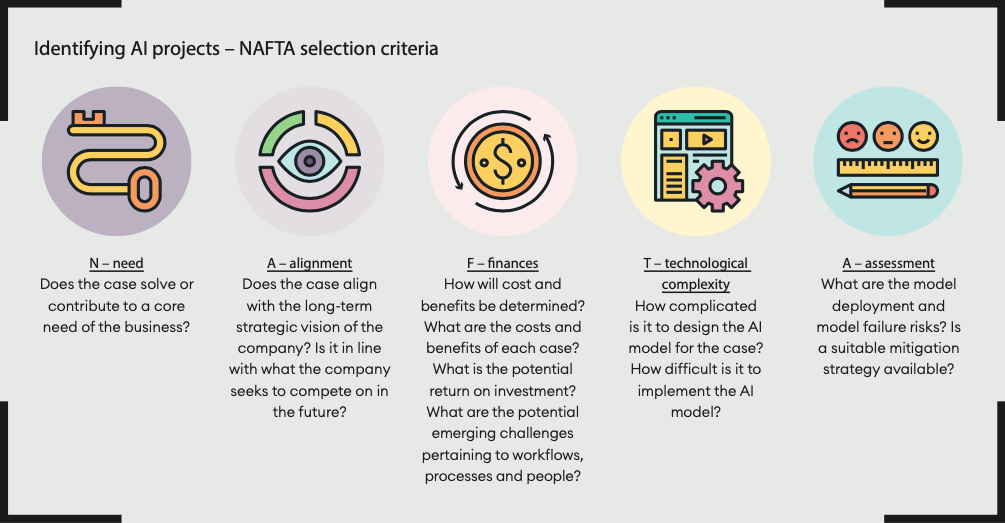Artificial intelligence has transformative potential – but where to begin? Get started with a systematic evaluation of the opportunities
To recover swiftly from the pandemic, companies have become far keener to speed up digital transformation. Many have opted for automation as part of their approach, with artificial intelligence (AI) as the centrepiece. Turning such technology into a full automation solution often starts with putting together a pilot or proof of concept (POC).
Yet in our experience, POCs easily end in failure. Why? One reason is simply choosing the wrong problems to solve. Modern companies’ processes are often complex, thus affording many possibilities – and many false promises – for automation. Another reason stems from the misguided belief that implementing an AI-driven system is a technology project. It is not. If you’re solving a business problem, it’s a business project.
So how should organizations proceed to minimize the risk of failure?
Five proven steps
A systematic methodology is essential. Drawing on our client experience, we have come up with a five-step approach, which we call ‘AI Factory’, to improve the probability of success in locating and building POCs.
1 Gathering use cases
Begin by identifying all the possible prospects for AI-led automation. Take a holistic organizational view and revisit the current strategy. You may need to consider emerging needs and bottlenecks in existing processes – plus any existing data strategy and the quantity of data you have, or can collect.
At this stage, though, the amount and quality of data don’t matter that much. By far the most important point is taking a ‘business first’ mindset. Only through such a lens is it possible to see how use cases benefit the company. Gather as many use cases as possible without overly stringent criteria.
2 Conducting business analysis
Gathering use cases without much filtering can result in a huge number of them (one of our clients had more than a hundred). It is unrealistic to build a POC for them all, so the next step is a process of selection. We identify five criteria, which put more weight on business considerations than on the AI technologies themselves (see ‘NAFTA’ below).

3 Assessing technological feasibility
Next, evaluate the selected use cases on their technical merits. This is achieved through small experiments to demonstrate what the AI technology can – and cannot – do. Where possible, compare different potential solutions: off-the-shelf, open source and customized. This step is critical for gleaning insight into the technology without a significant upfront time and capital investment. The result of this step is, for each use case, a recommendations report that combines findings from both the business and technical feasibility analyses. These reports guide the preliminary solution design and architecture suggestions that help move the cases to the development phase.
4 Developing and improving the proof of concept
The perceived benefits of the identified cases need to be turned into first tangible results, in the form of a POC. This is subsequently presented to the wider business for feedback, which in turn informs further improvements. This cycle continues until the POC meets the success criteria established by the business.
5 Working out the implementation plan
Any technology used by business can only come to true fruition if it is properly integrated into operations. The final step is to develop a full implementation plan based on what has been learned. Present it to the wider company to elicit ideas that help accelerate delivery. With its full implementation plan, the business is now in the best possible position to decide whether or not to pursue the AI solution.
Putting it in practice
We have used our five-step AI Factory approach in a current engagement with a UK government agency which, like many others, has faced increasing pressure on its labour-intensive operations thanks to the pandemic. It was imperative for the agency to identify and develop the right automation solutions quickly: not just to handle current demand, but to scale up capacity in anticipation of future needs. The agency was able to produce a full implementation plan for four use cases, each with integration plans and accurate costing evidenced by POC results, within just three months. It is estimated to have helped the agency accelerate their process automation efforts by 60%. The ultimate benefits to their services will be enormous.
Significantly, the agency committed to training sessions and ideation workshops for its senior leadership. Ensuring that the leadership team is equipped for the journey to AI automation is key. By getting team members involved from the very beginning, they can become more knowledgeable about AI over time, and better able to provide valuable feedback for POC development.
For any organization considering AI as part of digital transformation, it is essential to think through all considerations, both business and technology-related, carefully, systematically – and speedily. The pandemic has provided an impetus and a rationale for companies to ‘tech themselves out’ in a short space of time. Those that are armed with the best methodologies are likely to have the best chances of success with their digital transformation efforts.

